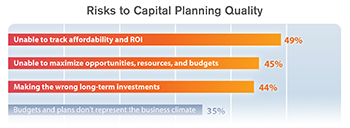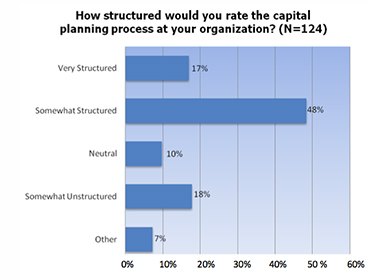I had the opportunity to interview Madison Laird, Executive in Residence at Planview, about some of the findings and nuggets from the State of Capital Planning Study. Madison shared some of his thoughts about portfolio management and long range financial planning which have been shaped by his career at companies like Cisco, Marimba and IBM. Together we looked at some of the top survey responses, like “How structured is your capital planning process?” and examined their implications.
One of the top three risks reported by 45% of financial executives was an inability to maximize resources, opportunities, and budgets.
As we wondered aloud about the root cause behind this trend, we found ourselves asking the obvious question: “What is it about traditional capital planning that limits finance from being assured they are optimizing resource and budgets accurately and acting on the right opportunities?”
After talking through several possibilities, a trend caught our attention. In one section of the survey 17% of participants reported their capital planning process was “very structured” and nearly 50% claimed to be “somewhat structured.”
I asked Madison, What is meant by structure in the planning process? He explained that structure refers to the definition and arrangement of elements in the planning process — elements like roles and responsibilities, data flows, events, tools, etc. Think of it as planning for the planning. Two extremes exist in planning: highly structured planning processes and those with little to no structure.
Highly-Structured
Many companies with highly structured planning processes may be resistant to change. Highly structured processes use flowcharts to depict organization or stakeholder swim lanes, with the time component of the process defined from left to right. These highly structured flowcharts make up the planning process and outline the various data inputs, outputs, and milestones including meetings and targets, and the roles and responsibilities for each swim lane.
Little to No Structure
When companies lack structure in their planning process, they often experience difficulties managing a business with multiple stakeholders, or they tend to conflate the planning and budgeting processes. Companies with relatively little structure in the planning process usually are not maximizing the strategic input that their stakeholders can provide.
According to Madison, the planning structure needs to be flexible. For example, stakeholders need to see a clear path through the planning process, but they also need the flexibility to request productive, timely changes in the process (e.g. revise templates and meeting agendas — things in the flowchart).
For Madison, a process with a flexible structure meets several key criteria.
- The process meets the strategic needs of the decision makers.
- The process gathers both quantitative and strategic input from line of business stakeholders.
- The process facilitates sharing of information as necessary to create alignment across lines of business.
An irony is that a highly structured process also tends to be the most flexible. The reason is that a highly structured process has all the elements defined, so it is easier to understand the implications when moving them around. A planning process that is somewhat structured (as most survey respondents indicated) may feel more flexible, but it is actually less flexible because a change can be quite disruptive. When an organization using a somewhat structured planning process has to respond to a requested change, the structure many not show all the effects that changes will have.
Consider a basic example. Suppose the decision-making stakeholders in a company decide that they would like to see information from the planning process reflect a five-year time horizon, instead of the typical three-year time horizon. A highly-structured process would allow users to be able to quickly identify the effected data flows, edit the effected spreadsheet templates, identify the impacted strategic shifts, edit the relevant meeting agendas and presentation templates, and leverage the appropriate communication mechanisms to convey the relevant changes to the effected stakeholders. For a somewhat structured planning process, it is unlikely that this type of change could be accommodated mid-stream. Even more likely, a somewhat structured planning process might not indicate the important impacts until it was too late. In these cases, a somewhat structured planning process would almost certainly fail to meet the criteria for a flexible structure.
Next week we will talk with Madison about what he calls ‘shadowboxing’ your way through the capital planning process, and how structure can lull finance into a false sense of security about the planning process.
I invite you to read the State of Capital Planning Study to gain additional insight on its findings. How would you rate the structure of your capital planning process?
Related post: Planning Millions of Dollars of Capital Investments using a Spreadsheet, Is it Sustainable?




